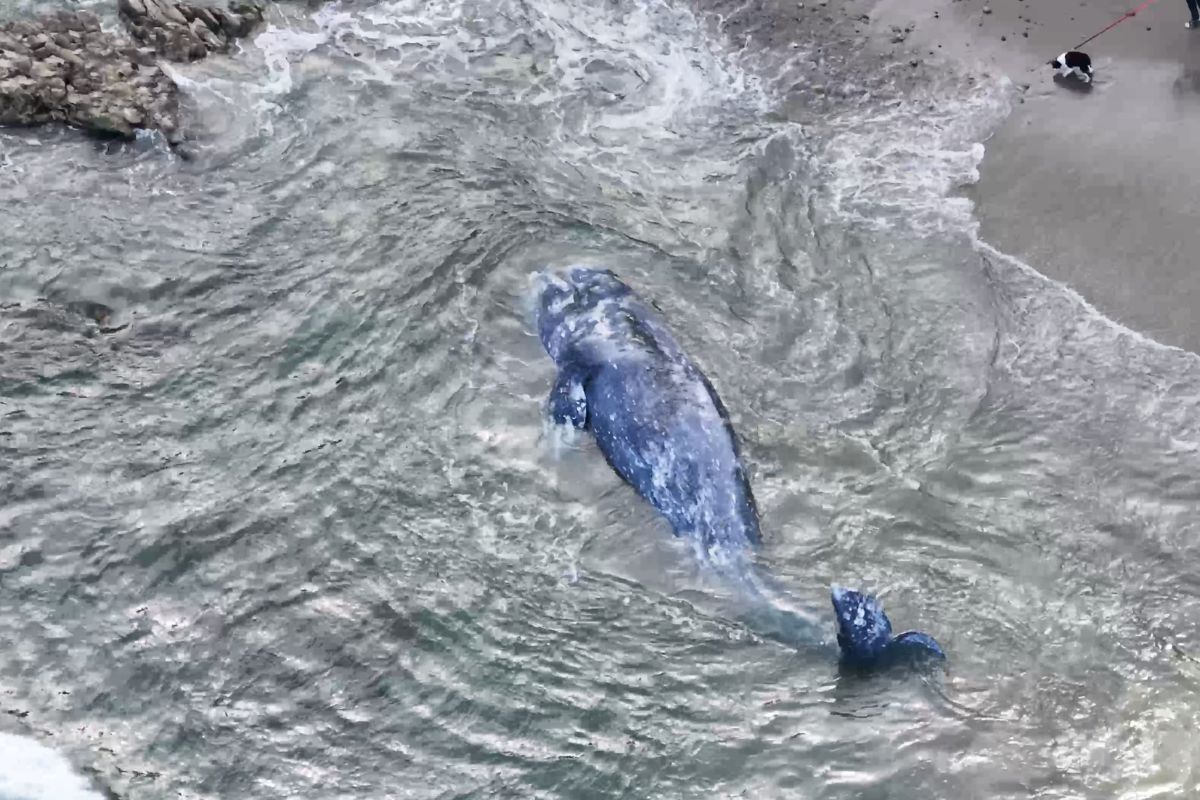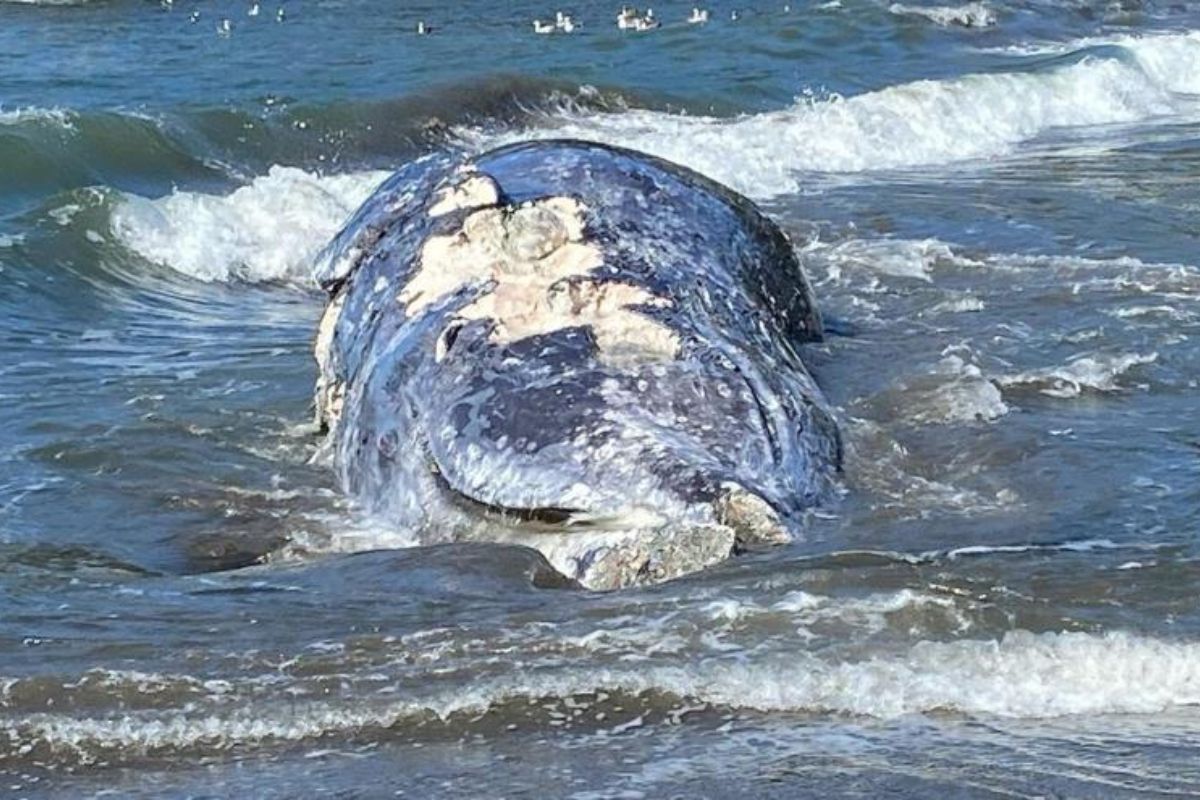Massive Gray Whale Stranding: Witness the awe-inspiring yet heartbreaking sight of a colossal gray whale stranded off the Southern California coast, fiercely battling the elements at Point Dume. This massive marine mammal, protected under the Federal Marine Mammal Protection Act, showcases its sheer size and majestic presence as it fights to break free. The urgent need for intervention is evident as the drone footage captures the whale’s struggles amidst the vast ocean backdrop. Stay tuned to uncover more about the environmental challenges faced by these magnificent creatures and the potential outcomes in store.
Drone Footage Captures Gray Whale Stranding in Malibu
The drone footage captured by photographer Cody Boone vividly depicts a gray whale stranded near the shoreline at Point Dume in Malibu, showcasing the distressing situation of the massive marine mammal as it is pushed back and forth by the relentless surf. The sheer size and power of the whale are evident as it struggles against the forces of nature, its massive body contrasting starkly with the crashing waves around it. The footage captures the whale’s futile attempts to free itself, highlighting the vulnerability of these majestic creatures when faced with such dire circumstances.
The whale’s movements are slow and labored, a stark contrast to its usual grace and agility in the open ocean. Its dark, mottled skin glistens in the sunlight, a testament to the harsh conditions it is enduring. The drone footage provides a unique perspective, offering viewers a close-up look at the whale’s plight and emphasizing the urgent need for intervention to ensure its survival.
As the whale is buffeted by the waves, it serves as a poignant reminder of the fragile balance between humans and marine life. The dramatic imagery captured in the drone footage serves as a powerful call to action, urging viewers to consider the impact of human activities on the natural world and the importance of conservation efforts to protect vulnerable species like the gray whale.
Gray Whale Profile
Gray whales, protected under the Federal Marine Mammal Protection Act, are renowned for their impressive size and remarkable migratory patterns. Weighing up to 90,000 pounds and measuring 40 to 45 feet in length, these majestic creatures undertake one of the longest annual migrations known in the animal kingdom. Their journey spans between 10,000 and 14,000 miles round trip, from their feeding grounds in the Arctic to the warmer waters of Mexico where they breed and give birth.
These gentle giants have distinctive mottled gray skin, often covered in patches of barnacles and whale lice. Their most striking feature is their heart-shaped blow, which can reach up to 12 feet high, making it a spectacular sight for onlookers. Gray whales possess no dorsal fin, but rather a series of small humps along their lower back, followed by a broad tail fluke that they use to propel themselves through the water.
Known for their curious and friendly nature, gray whales often approach boats, a behavior that has earned them the nickname ‘friendly gray giants.’ They are primarily filter feeders, sieving small crustaceans, plankton, and other tiny organisms from the ocean floor using baleen plates in their mouths. Gray whales play a vital role in marine ecosystems and hold a significant place in the hearts of many nature enthusiasts worldwide.
Environmental Challenges
Amidst the vast ocean expanse, a myriad of environmental challenges pose threats to the migratory journey of the Southern California gray whales. These challenges not only impact the individual whales but also have broader implications for the ecosystem in which they reside. Here are some key environmental challenges faced by the gray whales:
- Entanglement in Fishing Gear: The proliferation of fishing gear in the oceans increases the likelihood of gray whales getting entangled. This can lead to injuries, stress, and even death for these marine giants.
- Collisions with Ships: As shipping lanes overlap with the gray whales’ migration routes, the risk of collisions escalates. The sheer size and speed of ships make it difficult for whales to evade, resulting in severe injuries or fatalities.
- Predation by Killer Whales: Killer whales, also known as orcas, are apex predators in the ocean. They sometimes target gray whale calves during their migration, posing a significant threat to the species’ population dynamics.
- Climate Change Impacts: The changing climate affects the availability of food sources for gray whales, leading to disruptions in their feeding patterns and overall health. Additionally, rising sea levels and ocean acidification further exacerbate the challenges faced by these majestic creatures.
Addressing these environmental challenges requires a multifaceted approach involving stakeholders, policymakers, and the public to ensure the long-term survival of the Southern California gray whales.
ALSO READ: Illegal Cigarette Chute Leads to Alcohol Licence Revocation
News in Brief
Witness the dramatic sight of a stranded gray whale off the Southern California coast, battling against the elements at Point Dume. Protected by law, this colossal mammal’s struggle highlights the urgent need for conservation efforts. Drone footage by Cody Boone captures the distressing scene, emphasizing the whale’s vulnerability amidst crashing waves. Gray whales, known for their massive size and migration journeys, face environmental threats like entanglement in fishing gear and collisions with ships. Predation by killer whales and climate change further jeopardize their survival. Addressing these challenges demands collaborative action to safeguard the future of these majestic creatures. Stay tuned for updates on this critical conservation issue.
Our Reader’s Queries
When can you see GREY whales in California?
Gray whales migrate past California twice a year: from December to January heading south, and from mid-February to early May as they journey north.
What is the lifespan of a GREY whale?
Gray whales typically attain sexual maturity between five to eleven years of age or when they reach a length of 36-39 feet (11–12 meters). Their lifespan is estimated to be approximately 50–60 years.
Where are the gray whales now?
Once abundant across the Northern Hemisphere, gray whales are now primarily concentrated in the North Pacific Ocean, with two existing populations: one in the eastern and another in the western North Pacific.
Is it whale season in Southern California?
Interested in observing gray whales, humpback whales, dolphins, and sea lions? Turner recommends visiting Southern California from January to April. Prefer spotting blue whales and finback whales? Plan your trip between May and September. For minke whales enthusiasts, October through December offers prime viewing opportunities.


